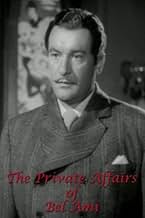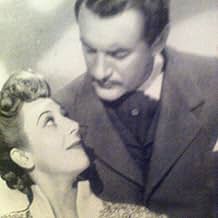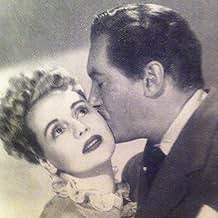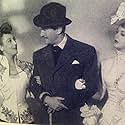CALIFICACIÓN DE IMDb
6.7/10
874
TU CALIFICACIÓN
Agrega una trama en tu idiomaIn 1880, in Paris, chance brought together two former comrades-in-arms - Charles Forestier, who had become a journalist for "La Vie française" - and Georges Duroy, idle since leaving the six... Leer todoIn 1880, in Paris, chance brought together two former comrades-in-arms - Charles Forestier, who had become a journalist for "La Vie française" - and Georges Duroy, idle since leaving the sixth regiment of hussars.In 1880, in Paris, chance brought together two former comrades-in-arms - Charles Forestier, who had become a journalist for "La Vie française" - and Georges Duroy, idle since leaving the sixth regiment of hussars.
- Dirección
- Guionistas
- Elenco
Susan Douglas Rubes
- Suzanne Walter
- (as Susan Douglas)
- Dirección
- Guionistas
- Todo el elenco y el equipo
- Producción, taquilla y más en IMDbPro
Opiniones destacadas
"The Private Affairs of Bel Ami" is one of the most unusual films to come out of Hollywood during the Golden Age of Hollywood (1920-1950). An adaptation of a Guy de Maupassant work, "Bel Ami" honestly and bitingly portrays an "homme fatale", a man who uses sex to gain social, economic, and political power. This is the only film, to my knowledge, that portrays such a phenomenon that in real life has been much more common than is commonly held.
George Sanders was never better than as Georges DuRoy. His playing displays the numbing of feelings, desperation of a life of poverty and low social rank, and misogyny that propel him to do what he does. No film character in the Golden Age of Hollywood was as blatantly hateful of women as Georges DuRoy. Witness the scenes with Sanders and Marie Wilson!
The female characters display a moderness in attitudes, relationships with men, and an awareness of their roles in their relationships with Georges DuRoy that is startling not just for 1880, but for 1947, when the film was released. Only French and some Italian films of the 1960's have equalled that frankness by female characters of what their place is in the lives of men.
Ann Dvorak carries much of the film gracefully and with a strong, frank portrayal of a woman much like Georges DuRoy and unapologetic about it. This is definitely Dvorak's finest and the showiest role of her career. Unfortunately, it did not propel her to major stardom and she retired from acting only three years after filming "The Private Affairs of Bel Ami".
Angela Lansbury proved here in this early film of her career what a fine character actress she is. Her portrayal of Clothilde could've been pathetic. Instead, Clothilde emerges as well-rounded character who is never tiresome to watch.
Marie Wilson never got a dramatic part like the one in this film as a Folies Bergere dancer. She only proves the point that behind every great comedienne lies a fine dramatic actress. She truly evokes a character, not the dumb blonde comedy relief that was her stock-in-trade.
A surprising number of top character actors in this film! The film's look and score are very noirish. That only highlights the modernity of the characters in the film, much like 2000's "Moulin Rouge".
The movie looks and plays like an RKO-Radio film noir of the mid-'40's.
Cool concept. The startling use of color for the one scene in which it is used only adds to the uniqueness of this film's acting and look.
The only drawback is the use of decidedly obvious painted backdrops. They only highlight the low budget that was obviously involved in making the film. Too bad, while the rest of the sets appear well-lighted and -appointed.
An arresting film! Definitely worthy of critical and popular reevaluation!
George Sanders was never better than as Georges DuRoy. His playing displays the numbing of feelings, desperation of a life of poverty and low social rank, and misogyny that propel him to do what he does. No film character in the Golden Age of Hollywood was as blatantly hateful of women as Georges DuRoy. Witness the scenes with Sanders and Marie Wilson!
The female characters display a moderness in attitudes, relationships with men, and an awareness of their roles in their relationships with Georges DuRoy that is startling not just for 1880, but for 1947, when the film was released. Only French and some Italian films of the 1960's have equalled that frankness by female characters of what their place is in the lives of men.
Ann Dvorak carries much of the film gracefully and with a strong, frank portrayal of a woman much like Georges DuRoy and unapologetic about it. This is definitely Dvorak's finest and the showiest role of her career. Unfortunately, it did not propel her to major stardom and she retired from acting only three years after filming "The Private Affairs of Bel Ami".
Angela Lansbury proved here in this early film of her career what a fine character actress she is. Her portrayal of Clothilde could've been pathetic. Instead, Clothilde emerges as well-rounded character who is never tiresome to watch.
Marie Wilson never got a dramatic part like the one in this film as a Folies Bergere dancer. She only proves the point that behind every great comedienne lies a fine dramatic actress. She truly evokes a character, not the dumb blonde comedy relief that was her stock-in-trade.
A surprising number of top character actors in this film! The film's look and score are very noirish. That only highlights the modernity of the characters in the film, much like 2000's "Moulin Rouge".
The movie looks and plays like an RKO-Radio film noir of the mid-'40's.
Cool concept. The startling use of color for the one scene in which it is used only adds to the uniqueness of this film's acting and look.
The only drawback is the use of decidedly obvious painted backdrops. They only highlight the low budget that was obviously involved in making the film. Too bad, while the rest of the sets appear well-lighted and -appointed.
An arresting film! Definitely worthy of critical and popular reevaluation!
Maupaussant's roaring tale of the rise of Duroy is tamed slightly in this version, with George Sanders bumbling rather scheming his way to the top. It's let down by some poor production values, although the dueling scene at the end is well handled. Worth watching for the shocking view of 'The Temptation of St Anthony' in ultra-modern colour (about three quarters the way through) alone.
In the 1880's, a handsome rake schemes his way to the top of French society leaving a trail of exploited women in his wake.
I was about to slam Sanders' performance as a wooden one-note. Note how in the many close-ups his expression rarely changes, conveying little or no emotion, regardless the situation. Then it occurred to me. That's exactly right for such a heartless egotist as Duroy. In fact, he feels no emotion. Instead he's a walking calculator in the way he uses people. In place of warmth or animated charm, he seduces women with a strongly masculine presence and complete self-assurance, which Sanders conveys, in spades. Note too, how in the dueling scene, Duroy looks on impassively while his opponent musters strength to shoot him. Now a lack of emotion while staring death in the face is either evidence of an iron will or a simple lack of feeling. Of course, as an actor, Sanders can emote subtly or otherwise when called upon, as his lengthy career shows. So I figure his impassive manner in this movie is intended to define Duroy's character, and is not a deficiency on either the actor's or director's part.
Anyway, the movie itself amounts to a triumph of parlor room refinement. I especially like Lansbury. Her baby-face Clotilde provides enough meaningful emotion to engage the audience in ways that Duroy does not. In fact, the actresses, including a poignant Marie Wilson, are all well cast. Still, pairing the 40-year old Sanders with a girlish Douglas, half his age, amounts to a real stretch. But catch some of those parlor room sets that are doozies. The one with the checkered floor and striped wall had me cleaning my glasses. Overall, it's an oddly affecting morality play, with a style and taste that make even the painted backdrops somehow appropriate. Too bad this was the great Warren William's (Laroche) last movie. In terms of a commanding presence, he and Sanders belong together, as William's pre-Code films abundantly show. Nonetheless, this is one of the few features of the time to make a thoroughly dislikable character the central figure. And that took some guts. No wonder the film was an independent production.
I was about to slam Sanders' performance as a wooden one-note. Note how in the many close-ups his expression rarely changes, conveying little or no emotion, regardless the situation. Then it occurred to me. That's exactly right for such a heartless egotist as Duroy. In fact, he feels no emotion. Instead he's a walking calculator in the way he uses people. In place of warmth or animated charm, he seduces women with a strongly masculine presence and complete self-assurance, which Sanders conveys, in spades. Note too, how in the dueling scene, Duroy looks on impassively while his opponent musters strength to shoot him. Now a lack of emotion while staring death in the face is either evidence of an iron will or a simple lack of feeling. Of course, as an actor, Sanders can emote subtly or otherwise when called upon, as his lengthy career shows. So I figure his impassive manner in this movie is intended to define Duroy's character, and is not a deficiency on either the actor's or director's part.
Anyway, the movie itself amounts to a triumph of parlor room refinement. I especially like Lansbury. Her baby-face Clotilde provides enough meaningful emotion to engage the audience in ways that Duroy does not. In fact, the actresses, including a poignant Marie Wilson, are all well cast. Still, pairing the 40-year old Sanders with a girlish Douglas, half his age, amounts to a real stretch. But catch some of those parlor room sets that are doozies. The one with the checkered floor and striped wall had me cleaning my glasses. Overall, it's an oddly affecting morality play, with a style and taste that make even the painted backdrops somehow appropriate. Too bad this was the great Warren William's (Laroche) last movie. In terms of a commanding presence, he and Sanders belong together, as William's pre-Code films abundantly show. Nonetheless, this is one of the few features of the time to make a thoroughly dislikable character the central figure. And that took some guts. No wonder the film was an independent production.
Although hard to get into this film, with a protagonist who is very unlikable and who, for all his scheming, seems to be falling upward in the social hiearchy more than effectively manipulating those he seeks to use, the movie is worth watching in order to contemplate the young and beautiful Angela Lansbury and the older, wiser, but still beautiful Ann Dvorak. And for the climactic duel.(And some might find the couture sufficiently haute to be worth watching.)
The score by the great French composer, one of Les Six, Darius Milhaud, is pedestrian. Milhaud is not responsible for the annoying song "Bel Ami" which recurs far too often during the seemingly interminable 112 minutes of the movie in the version I saw.
The score by the great French composer, one of Les Six, Darius Milhaud, is pedestrian. Milhaud is not responsible for the annoying song "Bel Ami" which recurs far too often during the seemingly interminable 112 minutes of the movie in the version I saw.
an adaptation. and a great cast. perfect choice for Georges Duroy character. a subtle, precise, impressive George Sanders in one of his magnificent roles. so, the key is not manner to adapted the novel of Maupassant but the art of each actor. because this movie is scene for a lot of stars. the story is old but the play is new. the novel is French and the science of details and nuances makes this American movie fruit of French cinema. the tale of Bel Ami is, in great measure, grace of Sanders and his partners, slice of Dorian Gray. it is not a masterpiece but it is a very interesting lesson. to define a world, to discover a book, to escape from Nick Ormerod last adaptation spell. a film as old yellow picture. good beginning to visit a world, to joy with drops of old fashion cinema style, to rediscover few crust of emotions and reflection to our small and bleak world.
¿Sabías que…?
- TriviaThe producers held a contest for artists to create a painting about the temptation of Saint Anthony for use in this movie. The artists were paid five hundred dollars each and got to keep their paintings after the pictures toured the U.S. and Britain during 1946 and 1947. Although Max Ernst won the contest (receiving an extra two thousand five hundred dollars) and got his painting on-screen, Salvador Dalí's contribution (featuring a parade of spider-legged elephants tormenting the saint) became better known. The other artists who submitted paintings are Leonora Carrington, Ivan Le Lorraine Albright, Stanley Spencer, Eugene Berman, Paul Delvaux, Louis Guglielmi, Horace Pippin and Abraham Rattner. Artist Leonor Fini was also invited to contribute, but she didn't produce a painting.
- ErroresAt 9', a piano player and a violin player are doing a number. We hear a vibrato on the violin, but the left fingers of the player are not moving at all.
- Citas
Georges Duroy: [dying] I have been scratched by an old cat.
- Créditos curiososOpening credits: "This is the history of a scoundrel. The time is 1880 and the place is Paris."
- ConexionesReferenced in Bastardos sin gloria (2009)
- Bandas sonorasMy Bel Ami
by Jack Lawrence and Irving Drutman
Selecciones populares
Inicia sesión para calificar y agrega a la lista de videos para obtener recomendaciones personalizadas
- How long is The Private Affairs of Bel Ami?Con tecnología de Alexa
Detalles
- Tiempo de ejecución1 hora 52 minutos
- Color
- Relación de aspecto
- 1.37 : 1
Contribuir a esta página
Sugiere una edición o agrega el contenido que falta

Principales brechas de datos
By what name was Hombre de mundo (1947) officially released in India in English?
Responda




































